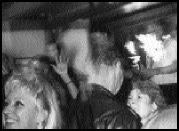FAST GIRLS: TEENAGE TRIBES AND THE MYTH OF THE SLUT by Emily White (Scribner, $22) Bailey/Coy Books, 414 E. Broadway, 323-8842; 7 p.m. Thurs., March 7
I DON’T know much about Emily White’s upbringing, and I can’t say whether her predominantly white, middle-class suburban high school was anything like mine. What I do know is that the world White describes in Fast Girls: Teenage Tribes and the Myth of the Slut—a roiling, pathologically sexualized mix of girls and boys in which one girl (the title’s “slut”) is victimized by everyone else—bears little resemblance to the one I grew up in, despite their superficial similarities. White’s goal in writing Fast Girls, she announces within the first dozen pages, is to deconstruct the “myth” of the high-school “slut.” Toward that end, White interviewed more than 100 girls and women who responded to an ad she placed in Dan Savage’s syndicated Savage Love column, a brash and blunt sex advice column that runs weekly in The Stranger, where White served as editor in chief from 1995 to 1999. The former “sluts” had several things in common: They were overwhelmingly white, middle class, and suburban; they went through puberty earlier than their classmates; they viewed themselves as “misfits”; and many had suffered sexual abuse.
All of this would seem to be fine fodder for a theory of the slut stereotype that takes into account women’s sexual histories, the insecurities of other girls and boys within the claustrophobic, intensely sexualized world of high school, and the complex interplay of teenage social groups. Instead, we get passages like: “[The slut’s] body begins to demolish and erase her interior life. Her body becomes the subject of a kind of visceral attention, a fiery need. . . . To awaken into the body of the woman when you are still a girl . . . is to be a true alien.” Maybe Naomi Wolf, whose Promiscuities was hotly praised and condemned for its highly personal style and paucity of verifiable evidence, can get away with this sort of stuff. But here such statements seem florid and overwrought. White never relents in her hyperbolic view of the tyranny of high-school stereotypes, even though—at least in this writer’s memory of teenage experience—the boundaries between groups are far more fluid than White makes them appear.
Overstatement isn’t Fast Girls‘ only shortcoming. The book is also marred by White’s refusal to examine her initial premise that the “slut” is a myth (she is not so skeptical, however, about other teenage stereotypes, such as the “little mothers,” the “natural helpers,” the “computer geeks,” and the “jocks”—the “tribes” of the book’s subtitle). Rather than demonstrating that there is no such thing as a “slut,” she takes that hypothesis as an assumption. Worse, White draws snippets from feminist, philosophical, and psychological theory seemingly at random—briefly lighting on Jungian archetypes before fluttering away to touch down again at Catholic theorist Dietrich von Hildebrand’s demonization of so-called “loose women” during the 1930s. (Movies, including the teen horror genre and the good-virgin-vs.-evil-whore variety, also get considerable play.)
MANY OF WHITE’S conclusions follow from the wispiest of premises; for example, she writes that the monotonous geography of suburbia facilitates the spread of rumors about the “slut,” because “a story recounted on a bathroom wall in one building will be written in a note passed in class in another building down the street. The buildings are almost identical, the structures echo one another, and so the girl can be easily translated.” In another instance, White reports that boys and girls latch onto one fellow student as the “slut” in order to escape the “sexual darkness” that threatens them. The “slut,” because she represents that darkness, “must be destroyed for everyone else to move toward the light; she must be sacrificed in the mythic process toward enlightenment. . . . ” White even speculates that other girls are jealous of the sexual attention boys lavish on “sluts” because so many of them never learned to masturbate. Girls get so sexually frustrated, she suggests, that they “become unhinged, unmoored. They have no idea how to calm themselves down.” If that theory sounds familiar, it’s because it’s been around for more than 100 years; well into the early 20th century, many people believed that women suffered periodic bouts of “hysteria” only curable through masturbation.
That’s not to say that Fast Girls is all recycled pseudo-psychological schlock. Intuitively, it’s hard to argue with many of White’s theories: Teenagers do victimize others because of insecurity, and girls do feel threatened by peers who steal boys’ attention. And White’s initial instinct—to root her book primarily in interviews with former “sluts,” rather than relying solely on theory and statistical evidence—pays off more often than it flops. Chapters about the coping mechanisms of former “sluts” and the exclusion of the urban poor and minorities from the “slut narrative” are also engaging, if a bit off topic. But despite the bright spots that sporadically enliven Fast Girls, White never quite manages to rise above her unwieldy prose and lackluster argumentative style. Ultimately, the book jacket’s glowing description of the author’s “feminist voice”—”as bold as Susan Faludi’s or Naomi Wolf’s”—appears to be a little premature.







